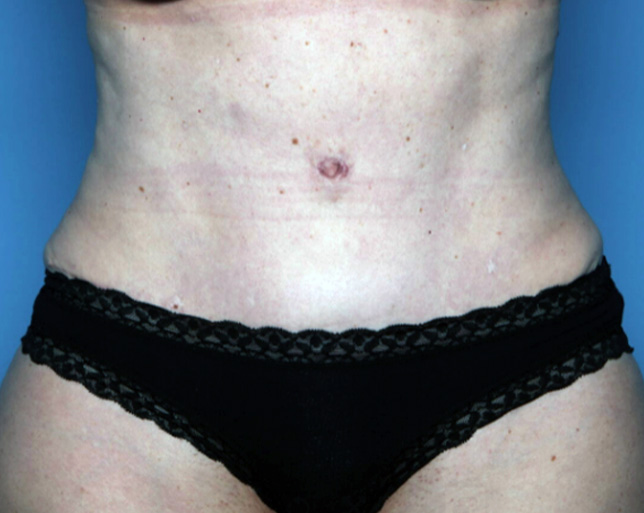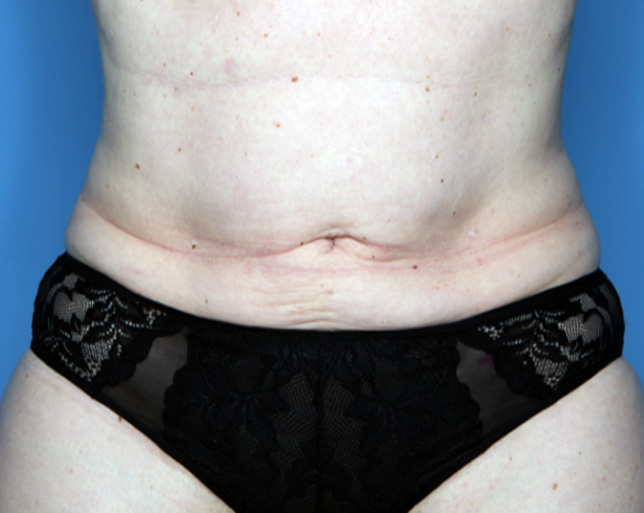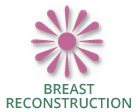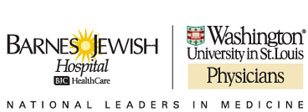FACELIFT SURGERY (RHYTIDECTOMY)
Restore a Naturally Younger-Looking, Refreshed, and Vibrant Appearance in St. Louis, MO
Skin starts to lose its elasticity and facial tissues tend to lose their volume as we age. This can result in a variety of cosmetic changes, including the development of jowls, deep wrinkles, and loose skin on the neck area. Although non-surgical options continue to play a major role in delaying signs of aging, a surgical facelift or rhytidectomy is still the gold standard. There is no non-surgical approach that can replicate the dramatic and comprehensive results you can achieve with a facelift. West County Plastic Surgeons specializes in providing facelifts for St. Louis men and women who are hoping to rejuvenate and freshen their appearance in 2024.
If you are interested in learning more about the advantages of a facelift, contact our St. Louis-based West County Plastic Surgeons office by phoning (314) 996-8800, requesting your consultation online, or emailing us today.
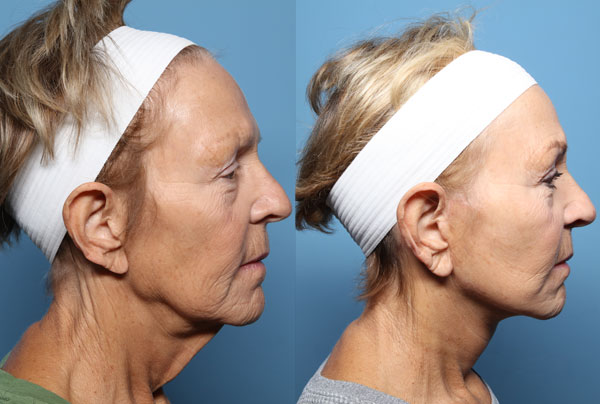
Before-and-after photos of facelift results: Click here
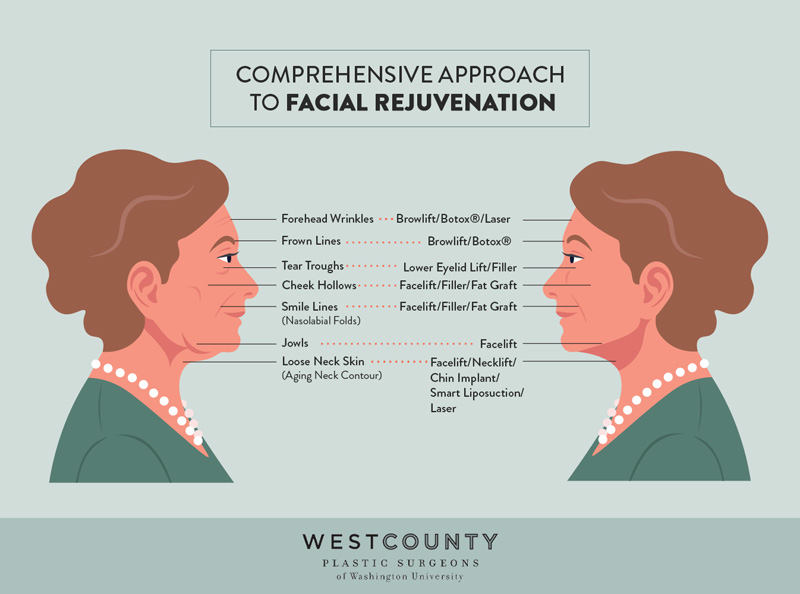
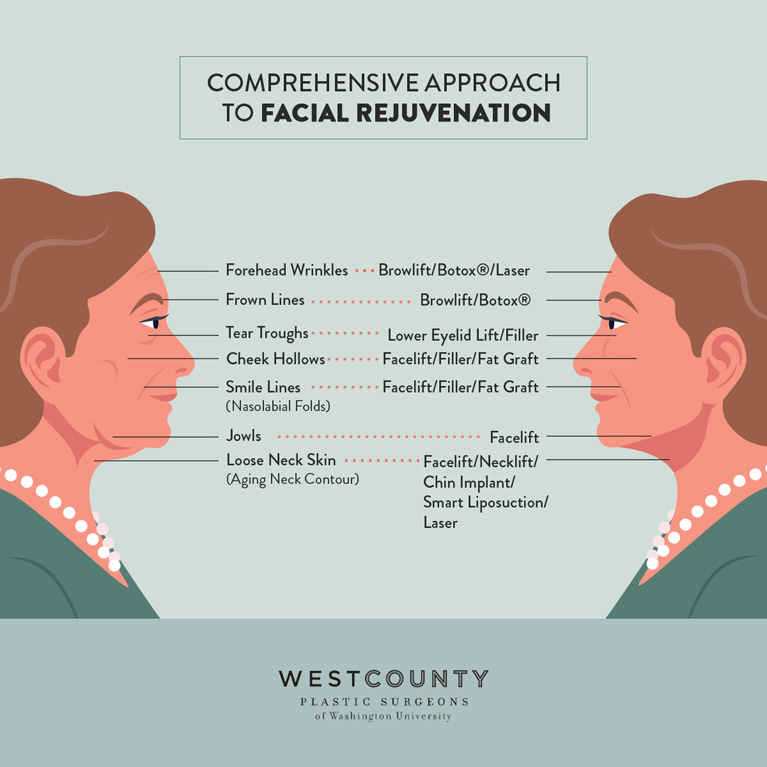
What Is a Facelift?
Why would someone get a facelift? What are the benefits of a facelift? These are some of the most common questions plastic surgeons Dr. Terry Myckatyn and Dr. Marissa Tenenbaum are asked by patients seeking a more youthful look.
Also known as a rhytidectomy, a facelift works by tightening the skin on the lower face to smooth nasolabial folds (deep creases between the cheeks and upper lip), define the jawline, reduce droopy skin or “jowling” along the jaw, and correct sagging or wrinkled neck skin. Liposuction below the chin is often used in conjunction with a rhytidectomy. Fat transfer or fat grafting is also used to help restore a more youthful but natural appearance to the midface. In spite of many alternative procedures and treatments available, facelift surgery remains the gold standard in facial rejuvenation simply because it can deliver the greatest, most lasting improvements with one procedure.
Who Is a Good Candidate for a Facelift?
Now that you have a basic idea of how facelift surgery works, you may also be thinking, “How do you know when you need a facelift?” A facelift could be a good option to consider if you are self-conscious about the appearance of your face and neck because of sagging skin, you believe your face makes you appear older than you feel internally, or you feel as if an aging appearance is having a negative impact on your career, relationships, or social life.
A facelift is a highly individualized procedure that should be done for yourself rather than to meet someone else’s desires. It can help to restore the youthful contours of the cheeks and address sagging on the jawline and neck area. The best candidates for rhytidectomy are healthy individuals who do not have serious medical conditions that impair healing, non-smokers, and those with a positive outlook and realistic expectations. This procedure is best for patients who have sagging skin on the face and neck but still maintain some elasticity in their skin. It is ideal for individuals who have a strong, well-defined bone structure.
What Are the Different Types of Facelifts?
West County Plastic Surgeons performs four primary facelift types at our St. Louis practice: standard, short-scar, neck lift and mini-facelift. These versions differ based on the number of facial layers that are lifted, the length of the incision used to perform the procedure, and subtle nuances in technique. In general, procedures that involve longer incisions or more extensive manipulation of the facial tissues typically offer more dramatic results, but they also generally involve longer recovery time. Dr. Tenenbaum or Dr. Myckatyn will explain which procedure they think will best suit your needs. For detailed information about the standard facelift options we offer, see below:
Standard Facelift
In this procedure, one long incision is created along the hairline above the ear, through the natural crease in front of the ear, behind the ear, and into the upper neck hair. The skin is then lifted toward the central face and re-draped in a more youthful position. In addition, the supportive connective tissue of the face, or superficial myoaponeurotic system (SMAS), is either pulled, partially removed and tightened, or elevated and pulled in an upward direction before being secured in a more youthful position. Most facelifts include some combination of these techniques; the degree to which the skin and SMAS are manipulated usually differentiates the various techniques. In addition, some facelifts will transition between the skin, SMAS, and even facial muscle planes to achieve the desired goals of facial rejuvenation. The best candidates for a standard facelift are 45 or older and are seeking a more dramatic rejuvenation of the face, a significant reduction or tightening of redundant neck skin, or both.
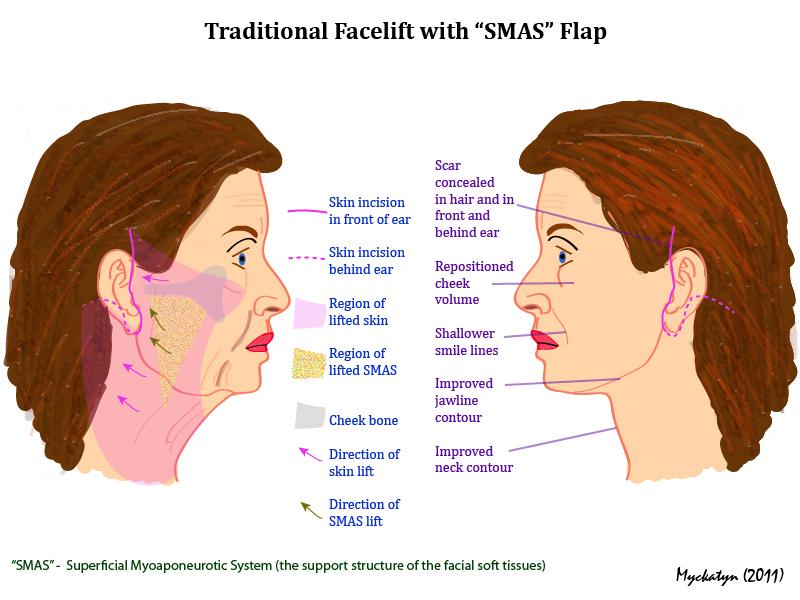
Short-scar facelift. A relatively short scar differentiates the short-scar from the traditional facelift. In a short-scar procedure, the scar usually starts in the hair just above the ear and then extends in the natural crease in front of the ear. It stops at the base of the ear rather than extending behind the ear. As in a standard procedure, the skin and SMAS layers are elevated and manipulated. To address fat pads under the jaw, a patient may undergo neck liposuction along with a short-scar facelift. The best candidates for this procedure are people seeking to refine features of the central and lower thirds of the face around the cheeks and jawline, but who do not have large amounts of loose neck skin.
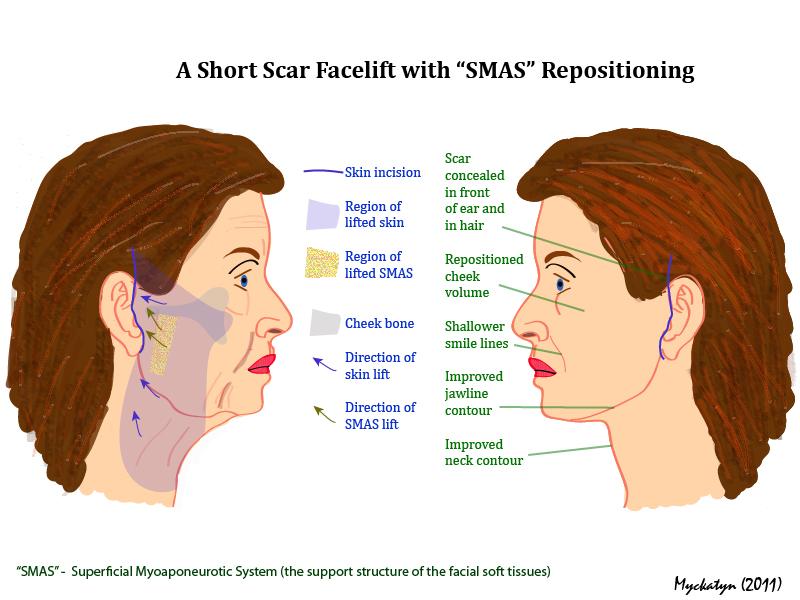
Neck lift. This procedure involves creating an incision that travels behind the ear and sometimes curves in front of the ear. The goal of this surgery is to improve the neck skin through a combination of skin-tightening, stitch, muscle-pulling, and fat-removing techniques. The best candidates for a neck lift are people who are satisfied with their facial appearance, but wish to improve only loose or excess skin on their neck.
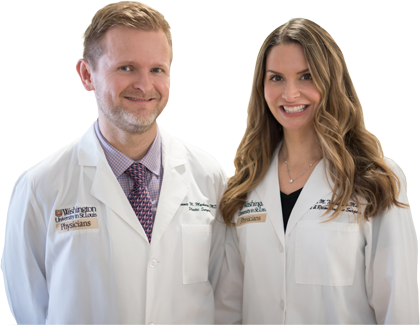
Dr. Terry Myckatyn and
Dr. Marissa Tenenbaum:
Trusted. Experienced. Committed.
Mini-facelift
This in-office procedure is performed with the patient under local anesthesia. It involves creating a short incision in front of the ear. The skin is then lifted and re-draped to a more youthful position, and the SMAS layer is repositioned to provide a longer-lasting result. A mini-facelift is best for people who seek an office-based facial rejuvenation that will provide moderate improvements to the central and lower thirds of the face. Combined with fractionated laser resurfacing or other office-based procedures like upper-lid blepharoplasty and neck liposuction, the mini-facelift can serve as part of a comprehensive facial rejuvenation package that can be performed in a comfortable office setting.
Click here to view an informative video on facelifts.
To find out more about a facelift, contact our St. Louis West County Plastic Surgeons office by calling (314) 996-8800, submitting a contact form, or emailing us today to request a consultation.
How Do You Prepare for a Facelift?
Initially, you will talk to us about facelift surgery so that we can discuss your past and current medical conditions. To prepare for a rhytidectomy, patients may need to get lab testing or a medical evaluation, take certain medications (or adjust how they take certain medications), apply certain skin care products to the skin on their face, avoid smoking, and avoid taking medications or supplements that increase bleeding, such as aspirin and anti-inflammatory drugs.
What Happens During Facelift Surgery?
Anesthesia: Standard and short-scar facelifts are usually performed with the patient under general anesthesia, while mini-facelifts are typically performed in the office with the patient under local anesthesia.
Length of procedure: 1 to 5 hours, depending on technique chosen
Estimated recovery time: Patients can return to work after 5 to 14 days, depending on the technique chosen, but should avoid vigorous activities for 2 to 3 weeks. Visible bruising or swelling should resolve within 1 to 2 weeks. To learn how to prepare for a facelift and what to expect afterwards, click here to download our patient instructions.
Side effects: Common side effects include bruising, swelling, a well-hidden scar, and some cheek numbness. Muscles that raise your eyebrows or lift the bottom corners of your lips may be weak for 1 to 3 weeks after surgery. Click here to download a detailed consent form from the American Society of Plastic Surgeons that lists the risks and benefits of this procedure.
What Are the Results and Long-Term Outlook After a Facelift?
Another thing patients frequently ask is, “How many years does a facelift last?” Unfortunately, there is nothing that can stop the natural aging process. A facelift can restore a youthful appearance to your face and neck, but aging may cause the skin to sag again over time. Still, the results may last for 10 years or more on average—or until the patient has aged enough to require additional work. The surgery is designed to not only achieve a natural outcome but also to provide results that age naturally with you.
You will need to take good care of yourself if you want to maintain the results of a facelift and ensure that your contours look good in the following years. It’s recommended that you avoid smoking, apply sunscreen daily, use non-surgical skin rejuvenation procedures, and maintain a stable weight if you want to look your best.
Why Choose West County Plastic Surgeons of Washington University for a Facelift?
Thousands of patients have trusted board-certified plastic surgeons Dr. Terry Myckatyn and Dr. Marissa Tenenbaum to perform their facelift surgery. At West County Plastic Surgeons, we believe that once you schedule your initial consultation, you will understand why: Our patients come first, so we make every effort to be approachable, compassionate, and good listeners. We value good communication, because it helps us meet each patient’s individual expectations. In addition, because we are part of the Washington University School of Medicine, our surgeons stay abreast of the most advanced techniques and technologies in plastic surgery so that we can help you achieve beautiful, satisfying, safe results.
Other Facial Rejuvenation Options: Which Cosmetic Procedures Complement Facelift Surgery?
Although a facelift is a plastic surgeon’s most powerful technique for rejuvenating the lower two-thirds of the face and neck, it does have a few limitations that can be addressed by other techniques. When performed together, the following can provide a comprehensive approach to facial rejuvenation:
- Fractionated laser resurfacing. Fractionated laser resurfacing provides an effective, low-downtime solution for treating fine wrinkles and blotchy skin throughout the face. It can also address the deeper wrinkles around the mouth and eyes.
- Upper-lid blepharoplasty (upper-eyelid lift).A facelift does not address issues concerning the upper eyelid. An upper-lid blepharoplasty provides crisper contour to the upper eyelid by removing redundant skin.
- Lower-eyelid blepharoplasty (lower-eyelid lift). Depending on the style performed and your specific concerns, a facelift effects only moderate improvement to the lower eyelids. To rejuvenate this area, we recommend a lower-lid blepharoplasty, which tightens extra skin, removes fat bulges, and smooths the contour between the lower eyelid and the cheek.
- Brow lift (forehead lift). Whereas a facelift rejuvenates the lower two-thirds of the face, a brow lift can help rejuvenate the upper face. This procedure reduces forehead and frown-line wrinkles, and it repositions the eyebrows with well-concealed incisions.
- Fat grafting. Autologous (your own) fat grafting, also know as fat transfer, can restore lost facial volume and rejuvenate your appearance. Your own fat may be used to replace lost volume in the lower cheekbone area, the folds between the cheeks and the upper lips, and between the jowl and the chin. This is very commonly combined with facelift surgery.
- Dermabrasion. This technique removes a superficial layer of skin. This skin then heals over the next few days, and the new skin looks smoother and has fewer wrinkles.
Other non-surgical approaches for restoring a younger facial appearance include:
- Dermal Fillers. Hyaluronic acid fillers are injections of a soft, gel-like material beneath the skin to add volume to areas that have been depleted, reduce wrinkles, or improve facial definition. Biostimulatory fillers stimulate natural collagen growth to improve facial volume.
- BOTOX®. This treatment and other similar neuromodulators temporarily reduce dynamic wrinkles and address other aesthetic concerns associated with repetitive facial expressions.
Combining facelift surgery with other procedures or treatments can help you achieve your aesthetic goals. Contact us to learn more about which procedure—or combination of procedures—might be right for you.
Would you like to learn more about a facelift in St. Louis? If you have questions or would like to book a consultation with one of the surgeons at West County Plastic Surgeons of Washington University, please call (314) 996-8800 or request a consultation online.








